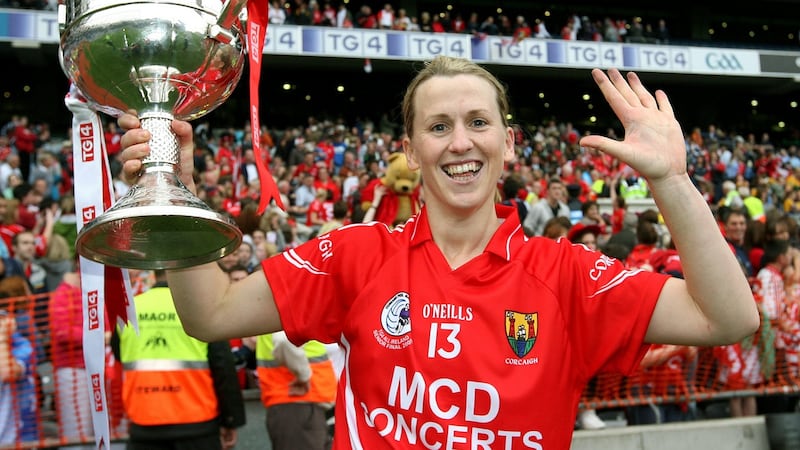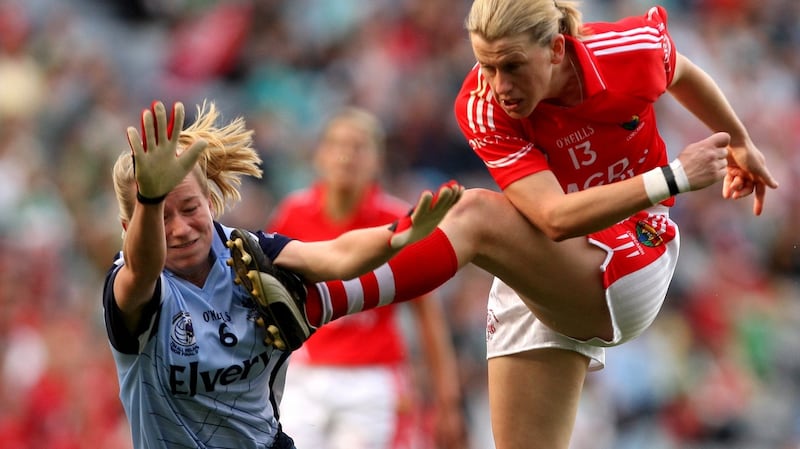Nothing stirs the gender equality debate quicker than the subject of money. Especially in sport. Whether it’s the prize money or appearance fee or endorsements, it seems women still get something of a raw deal compared to men.
Only for the vast majority of women involved in sport that doesn’t necessarily matter. There is some trickledown effect, but when it comes to money, the core issue remains funding.
Back in 2005, Sport Ireland – then the Irish Sports Council – introduced a new allocation of funding for the Women in Sport Programmel. At the launch event at the National Boxing Stadium, then minister for sport John O'Donoghue announced the extra €750,000 primarily aimed at increasing participation among younger woman.
At the time, Mary O’Connor was still juggling her career as a Cork dual star, in football and camogie, while also working as a games promotion officer in Limerick IT and coaching in schools in Cork. As a direct result of the Women in Sport Programme funding, she was hired by the Camogie Association to help deliver a new national development plan.

One small step in women’s funding, at least one giant leap for women in sport.
Because in December, O’Connor was appointed the new chief executive of the Federation of Irish Sport – which represents 74 National Governing Bodies (NGB’s) and 26 Local Sports Partnerships (LSP’s), or over 12,000 sports clubs nationwide. It makes O’Connor one of the most influential women in Irish sport and also one of the most important.
Ensuring maximum funding to the NGBs and LSPs is central to what the Federation of Irish Sport does, and again that’s not necessarily about addressing gender bias. What O’Connor has seen, and is herself proof of, is how targeted women’s funding is far from a token gesture; it can make an enormous difference.
“That first allocation of Women in Sport funding was built around the creation of development officers for the various sports,” says O’Connor, who in 2010 ended her 16-year dual intercounty career with 12 All-Ireland medals. Player of the year in 2006, she later captained the Cork’s women’s team to their five-in-a-row in 2009.
“At the time, camogie actually benefited from two new staff being added to work on that development end, and get more young girls say involved in the sport. Since then the Women in Sport funding has evolved into different spheres, around different programmes and initiatives.
Fantastic time
“I was still playing in 2005, and it was a fantastic time, having the job and it being part of my pastime as well. It was early days, but I’d been working in Gaelic games even before that, since I came out of college, starting as games promotion officer in Limerick IT, at a time when Limerick IT didn’t even have pitches.
“At the time there wasn’t an opportunity to work with the camogie association, simply because the money just wasn’t there. So once the funding was made available it was a huge opportunity for the sport.”
Later on Thursday, Sport Ireland announce their 2018 allocation of core funding to NGBs, including the Women in Sport Programme. For the past two years, that amount has been €600,000, targeting 26 NGBs, although neither of the two largest women’s sporting associations (women’s football and camogie) got a slice; instead, their core funding is deemed sufficient (€400,000 for women’s football in 2017, €395,000 for camogie).
Still that €600,000 is a small slice of the pie, especially as over €20m goes across all the NGBs and elite athletes. Which is where O’Connor comes in – highlighting the need, and use, of that funding.
There’s no denying some of the smaller NGBs are in greater need of that Women in Sport funding. Hockey Ireland got €35,000 in 2017 and has increased schoolgirl participation by 7,500; Rowing Ireland got €45,000, and over 15,000 female students participated in the ‘Get Going Get Rowing’ programme.
“For each of the last two years, it’s been €600,000 for Women in Sport. Of course women in sport are still underrepresented compared to men,” says O’Connor, who soon moved up the ranks to become director of development at the Camogie Association, in 2007, and was later acting CEO for 16 months.
“But that is changing, in terms of participation and involvement in coaching. Since 2011, women’s participation in sport as gone up by 2.5 per cent; that needs to keep happening, because it came from a low base.
“There’s definitely a lot more work to be done, but in fairness to the NGBs, and to the LSPs, they’ve actually been doing more, with less funding. So of course all these initiatives need more support, across both genders. What I admire about the NGBs is that I’ve seen how they’ve evolved over the last 10 years to engage with more women in sport. They’ve gone away from the rigid model of competition, and team formation, and gone more to the recreational side as well, to increase participation.
“Eventually, as a volunteer, or a player, it’s about creating the sense of community among these women, to stay involved in the sport, or whatever physical activity that is. The more women are involved, the more positivity that’s generated.
Mental health
“Sport is also going down the road of meeting more of the ills of society, things like mental health, so the more the Government can do to help that then the better. On top of the volunteering aspect, there are huge statutory regulations around sport now, Garda vetting, child protection, and so on, and all that requires additional funding.”
There is the slightly different subject of Sport Ireland funding at elite level, which is essentially merit-based, in theory at least without any gender bias. (There were 12 Athletics Ireland carded athletes in 2017; six were men, six women.)
While supportive of that, O’Connor believes elite-level funding always needs balancing with participation level funding.

“If you can increase the participation, it increases the base and the potential to come to the top, and compete at national and international level. A lot of funding still goes to that elite level, and it is important to keep that profile, but I think it’s also important to remember where they come from, and where they started out. I’m a big believer than women can be what they see.”
Still, success will always be some measure of the worth of that funding. UK Sport has invested heavily in sports where they believe they can be more successful (cycling, gymnastics etc), although O’Connor is cautious about drawing any direct comparisons
“Comparing ourselves to somewhere like the UK is difficult, given the big difference in population. You look at New Zealand, which is similar to Ireland in terms of population and interest in sport. In 2016, we had 28 elite women athletes who won medals at European or World level or Olympic level. Can that be increased?
“Yes, with more funding, we can always do more. High performance must be supported, but so too must the pathway. You can’t underestimate the power of success in getting more involved. At the same time, you can’t underestimate those who are influenced by their mother or their sister, because they are involved in sport.”
The Federation of Irish Sport was set up in 2002 to become a “voice” for all of Irish sport: “And we try to be a dynamic voice,” says O’Connor, “to the Government, and to any of the influencers who provide support to NGBs, LSPs, through funding or whatever resource.
“What I have found in my short time working here is that the amount of work NGBs and LSPs are doing to engage people in all areas of society, of all nationalities and all genders, is superb. They don’t all have the same ability to attract participants without additional support. It could be surfing, or tug-of-war, they all have the same right to be represented, and supported.
“Those 26 NGBs over the last two years have definitely benefited from the Women in Sport Programme. To be fair there is a commitment, and the Taoiseach wants to double the funding to the department in the next seven years. That can only help increase women’s participation at every level, to be playing, to be volunteering, to be the administrator or board member or the coach.
“Because only when you see more women involved across the board will you see the huge transition that people are talking about, and what is wanted. To be fair, things are on an upward curve, but we can’t take the foot off the pedal either.”
Current funding for Irish sport
€10.8m in NGB core funding
€7.2m in high performance funding
€1.8m in direct athlete investment
€600,000 to Women in Sport Programme
Women in Sport funding, 2017 breakdown
Athletics Ireland €35,000
Swim Ireland €70,000
Basketball Ireland €97,000
Cricket Ireland €20,000
Tennis Ireland €10,000
Badminton Ireland €40,000
Irish Sailing Association €18,000
Cycling Ireland €10,000
National Community Games €20,000
Hockey Ireland €35,000
Confederation of Golf in Ireland €15,000
Gymnastics Ireland €46,000
Rowing Ireland €45,000
Mountaineering Ireland €8,000
Volleyball Association of Ireland €48,000
Irish Squash €10,000
Triathlon Ireland €15,000
Table Tennis Ireland €25,000
GAA Handball Ireland €8,000
Irish Judo Association €4,000
Irish Surfing Association €7,000
Irish Deaf Sports Association €1,000
Irish Olympic Handball Association €5,000
Irish Tug of War Association €4,500
Bol Chumann na héireann €1,500
Baton Twirling Sport Association of Ireland €2,000
Total: €600,000












